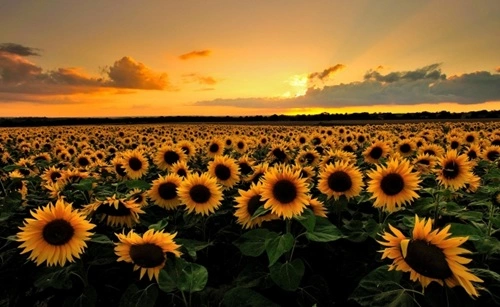Sunflower is a valuable oilseed crop that is grown mostly in the Kharif and Rabi seasons in India. This crop contributes toward the making of edible oil, livestock feed like oilcake, and provides diversification for farmers. Besides the core benefits, millions of farmers rely on this crop in terms of income, and the sunflower crop also helps with crop rotation. According to the latest advance estimates for 2024-25, Sunflower production in India is about 1.47 lakh tonnes, which makes it a crucial crop for the economy as well.
There are many states that have a higher contribution than others. Here, we will learn about the top 5 highest sunflower-producing states in India in 2025. The data is taken from government estimates and agricultural research data for the quantity and ranking. Let’s get started:

1. Karnataka – 0.79 Lakh Tonnes (79 Thousand Tonnes)
Karnataka remains the top sunflower-producing state with its 2024-25 advance estimates showing total sunflower production of 0.79 lakh tonnes. With such high production, Karnataka alone contributes about 53% of the total national sunflower production. Due to this, Karnataka becomes the dominating state in it. The top regions with the highest sunflower production are Raichur, Koppal, and Yadgir. These key regions have favourable rainfall during the vanakalam timing, which improves hybrid varieties. Even this favourable rainfall helps in getting a better yield from the less fertile soil. The critical issues like rainfall delays majorly impact the production number, which impacts the lives of millions of farmers and industries.
2. Haryana – 0.36 Lakh Tonnes (36 Thousand Tonnes)
Haryana holds the second position with its sunflower production. Haryana is estimated to produce about 0.36 lakh tonnes of sunflower in 2024-25. The sunflower acreage in the state is smaller than Karnataka’s, but productivity is higher in many districts. The dominating districts include those in northern and central Haryana, where sunflower is sown in the Vanakalam / Kharif season. Farmers in Haryana often benefit from more reliable rainfall or supplemental irrigation, good seed access, and local markets for sunflower. Its share of national production is around ~ 24-25% in total national output.
3. Telangana – 0.10 Lakh Tonnes (10 Thousand Tonnes)
Telangana emerges as the third-highest sunflower-producing state in India for 2024-25 with its 0.10 lakh tonnes of production. Telangana takes the lead with a yield rate, as the land under cultivation is smaller than that of many other states. The yield rate of sunflower production in Telangana is around 1641 kilograms per hectare. The production is relatively good, and this has become possible through better seed variety, technology, and infrastructure. The major sunflower growing regions in Telangana are Siddipet, Sangareddy, Gadwal, and Nagarkurnool. The share of Telangana in sunflower production is about 6-7% in total national output.
4. Maharashtra – 0.05 Lakh Tonnes (5 Thousand Tonnes)
Maharashtra is also a sunflower-growing state with lower input compared to the top-performing states. In 2024-25, it is estimated to produce ~ 0.05 lakh tonnes of sunflower from Vanakalam Kharif sowings. Its acreage is smaller (~ 0.098 lakh hectares in Kharif). Districts with sunflower production in Maharashtra are varied; often, areas with less water availability or marginal soils are where sunflower is a profitable option. Yield per hectare can fluctuate based on rainfall, seed variety, and input access. Its share of national production is modest, around ~ 3-4% in these estimates.
5. Bihar – 0.04 Lakh Tonnes (4 Thousand Tonnes)
Bihar also contributes to sunflower production with an estimated output in 2024-25 of about 4 thousand tonnes. The number may seem quite small, but considering the land under cultivation, the yield rate was better than in many other places. Farmers of Bihar grow sunflowers in the fallow post-monsoon season. Even though the yield rate is lower than in Karnataka or Haryana, it is still trying to increase production. The major reason behind lower production is less reliable rainfall and a smaller scale of hybrid seed usage. The share of Bihar in total national output is between 2%-3% in the 2024-25 estimates.
Bottom Line
The above five states combined share is more than 90% of the total national sunflower production. Even though the production of sunflowers in India is modest compared to other oilseeds, the crop is gaining importance due to rising edible oil demands, crop diversification, and improvement in hybrid seed quality and varieties.